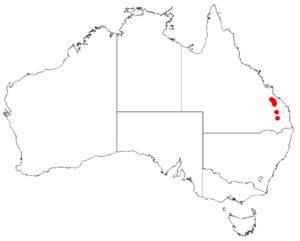Boronia palasepala facts for kids
Quick facts for kids Boronia palasepala |
|
|---|---|
| Scientific classification | |
| Genus: |
Boronia
|
| Species: |
palasepala
|
 |
|
| Occurrence data from Australasian Virtual Herbarium | |
Boronia palasepala is a special plant that belongs to the citrus family, called Rutaceae. It's found only in a small part of Queensland, Australia. This plant is a bushy shrub with many branches, simple leaves, and pretty pink or white flowers that have four petals.
What it Looks Like
Boronia palasepala is a shrub that stands upright and has many branches. It can grow up to about 2 meters (6.5 feet) tall. Its branches are covered with tiny hairs that look like stars.
Its leaves are simple and attach directly to the stem without a stalk. They are shaped like an oval or an egg, measuring about 14 to 42 millimeters (0.5 to 1.6 inches) long and 2 to 6 millimeters (0.08 to 0.24 inches) wide. The underside of the leaves is lighter in color and covered with many star-like hairs. The leaves also have a small, flat, wing-like part at their base, about 1 to 8 millimeters (0.04 to 0.3 inches) long.
Usually, you'll see one flower, but sometimes up to three, growing where a leaf meets the stem. These flowers grow on a very short stalk, less than 0.5 millimeters long. Each flower has four sepals, which are like small leaves that protect the bud. These sepals are broadly egg-shaped or triangular, about 4 to 6 millimeters long and 3 to 4 millimeters wide, and they are hairy on the back.
The four petals are pink to white, about 8 to 10.5 millimeters long and 4.5 to 6 millimeters wide. They are a bit hairy when they first appear. Inside the flower, there are eight stamens, which are the parts that produce pollen. These stamens are different lengths and shapes. Boronia palasepala flowers bloom from July to September.
How it Got its Name
Boronia palasepala was officially described in 1999 by a scientist named Marco F. Duretto. He published his description in a science journal called Austrobaileya.
The second part of its name, palasepala, comes from Latin words. "Pala" means "spade," and "sepala" refers to the sepals of the flower. So, the name means "spade-shaped sepals," because the sepals look a bit like the spade symbol you see on playing cards.
Where it Lives
This type of boronia plant grows in open eucalypt forests or woodlands. It prefers areas with sandstone soil. You can find it in Queensland, Australia, in places like near Monto and Biloela.
Looking After It
The Queensland Government has a law called the Nature Conservation Act 1992. Under this law, Boronia palasepala is currently listed as "least concern." This means that, for now, there are enough of these plants, and they are not considered to be in danger of disappearing.

